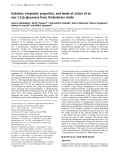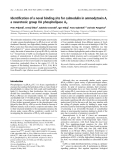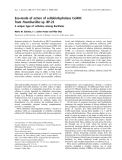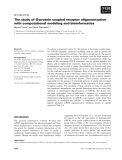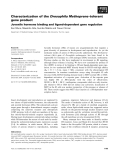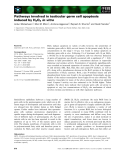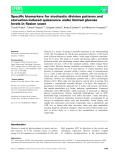
Molecular mode
-
An exo-1,3-b-glucanase has been isolated from cultural filtrate of Trichoderma viride AZ36. The N-terminal sequence of the purified enzyme (m ¼ 61 ^ 1 kDa) showed no significant homology to other known glucanases. The 1,3-b-glucanase displayed high activity against laminarins, curdlan, and 1,3-b-oligoglucosides, but acted slowly on 1,3-1,4-b-oligoglucosides. No significant activity was detected against high molecular mass 1,3-1,4-bglucans. The enzyme carried out hydrolysis with inversion of the anomeric configuration.
 9p
9p  system191
system191
 01-06-2013
01-06-2013
 46
46
 6
6
 Download
Download
-
The molecular mechanism of the presynaptic neurotoxicity of snake venom phospholipases A2(PLA2s) is not yet fully elucidated. Recently, newhigh-affinity binding proteins for PLA2 toxins have been discovered, including the important intracellular Ca 2+ sensor, calmodulin (CaM). In the present study, the mode of interaction of group IIAPLA2swiththe Ca 2+ -bound form of CaM was investigated by mutational analysis of ammodytoxin A (AtxA) from the long-nosed viper (Vipera ammodytes ammodytes).
 8p
8p  fptmusic
fptmusic
 16-04-2013
16-04-2013
 37
37
 3
3
 Download
Download
-
Sequence analysis of aPaenibacillussp. BP-23 recombinant clone coding for a previously described endoglucanase revealed the presence of an additional truncated ORF with homology to family 48 glycosyl hydrolases. The corres-ponding 3509-bp DNA fragment was isolated after gene walking and cloned inEscherichia coliXl1-Blue for expres-sion and purification. The encoded enzyme, a cellulase of 1091 amino acids with a deduced molecular mass of 118 kDa and a pI of 4.
 7p
7p  fptmusic
fptmusic
 16-04-2013
16-04-2013
 51
51
 3
3
 Download
Download
-
To achieve a structural context for the analysis of G-protein coupled recep-tor (GPCR) oligomers, molecular modeling must be used to predict the corresponding interaction interfaces. The task is complicated by the paucity of detailed structural data at atomic resolution, and the large number of possible modes in which the bundles of seven transmembrane (TM) seg-ments of the interacting GPCR monomers can be packed together into dimers and⁄or higher-order oligomers.
 13p
13p  fptmusic
fptmusic
 11-04-2013
11-04-2013
 50
50
 3
3
 Download
Download
-
Juvenile hormones (JHs) of insects are sesquiterpenoids that regulate a great diversity of processes in development and reproduction. As yet the molecular modes of action of JH are poorly understood. TheMethoprene-tolerant (Met) gene of Drosophila melanogasterhas been found to be responsible for resistance to a JH analogue (JHA) insecticide, methoprene. Previous studies onMethave implicated its involvement in JH signaling, although direct evidence is lacking.
 0p
0p  awards
awards
 05-04-2013
05-04-2013
 33
33
 1
1
 Download
Download
-
The chitosanase fromStreptomycessp. N174 (CsnN174) is an inverting glycoside hydrolase belonging to family 46. Previous studies identified Asp40 as the general base residue. Mutation of Asp40 into glycine revealed an unexpectedly high residual activity. D40G mutation did not affect the stereochemical mechanism of catalysis or the mode of interaction with sub-strate.
 12p
12p  vinaphone15
vinaphone15
 27-02-2013
27-02-2013
 38
38
 2
2
 Download
Download
-
Glucose as a source of energy is centrally important to our understanding of life. We investigated the cell division–quiescence behavior of the fission yeastSchizosaccharomyces pombeunder a wide range of glucose concentra-tions (0–111 mM). The mode of S.
 0p
0p  cosis54
cosis54
 05-01-2013
05-01-2013
 40
40
 2
2
 Download
Download
-
Bacterial type IV secretion systems (T4SS) form supramolecular protein complexes that are capable of transporting DNA or protein substrates across the bacterial cell envelope and, in many cases, also across eukaryotic target cell membranes.
 10p
10p  cosis54
cosis54
 05-01-2013
05-01-2013
 42
42
 4
4
 Download
Download
CHỦ ĐỀ BẠN MUỐN TÌM









